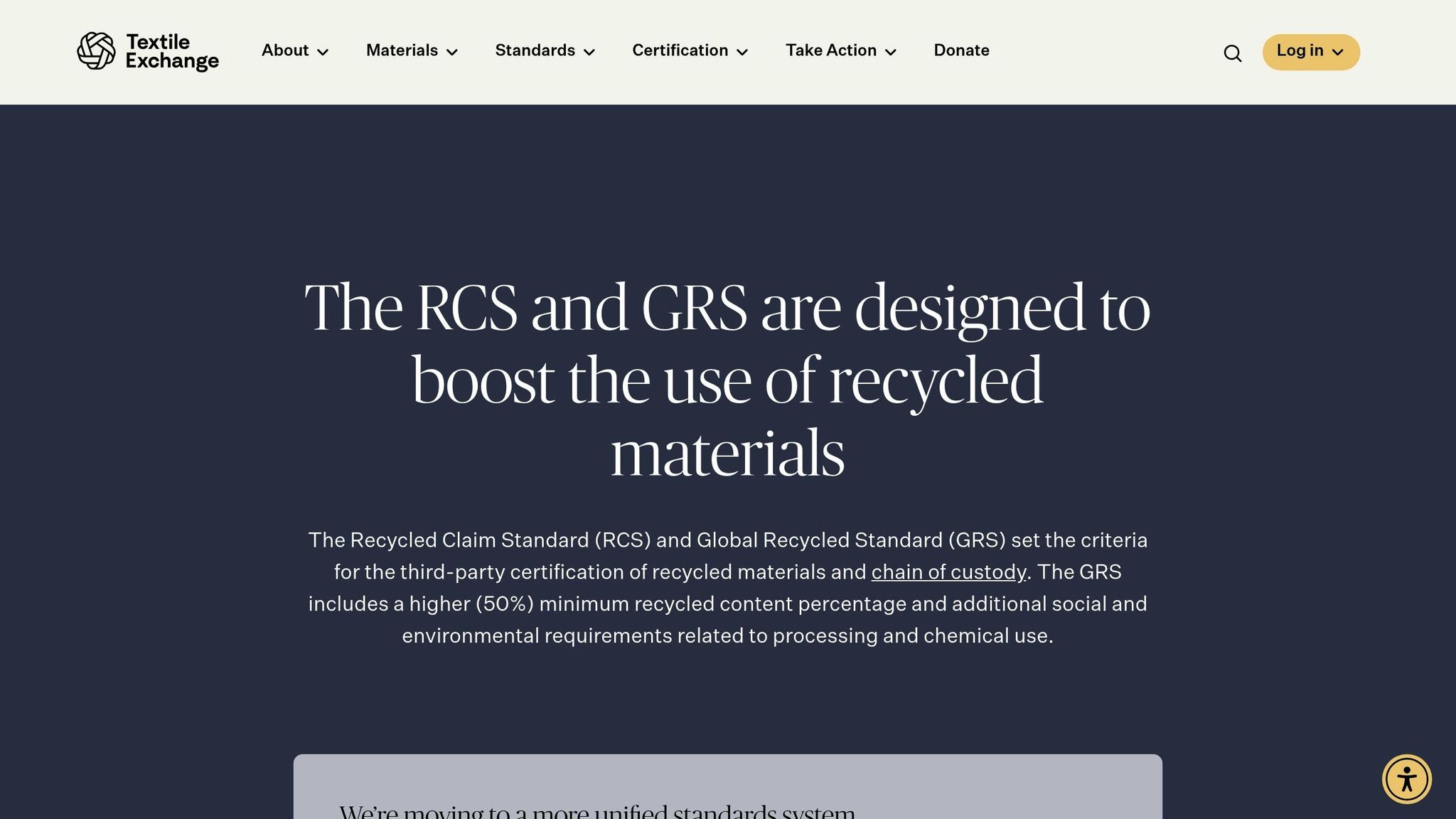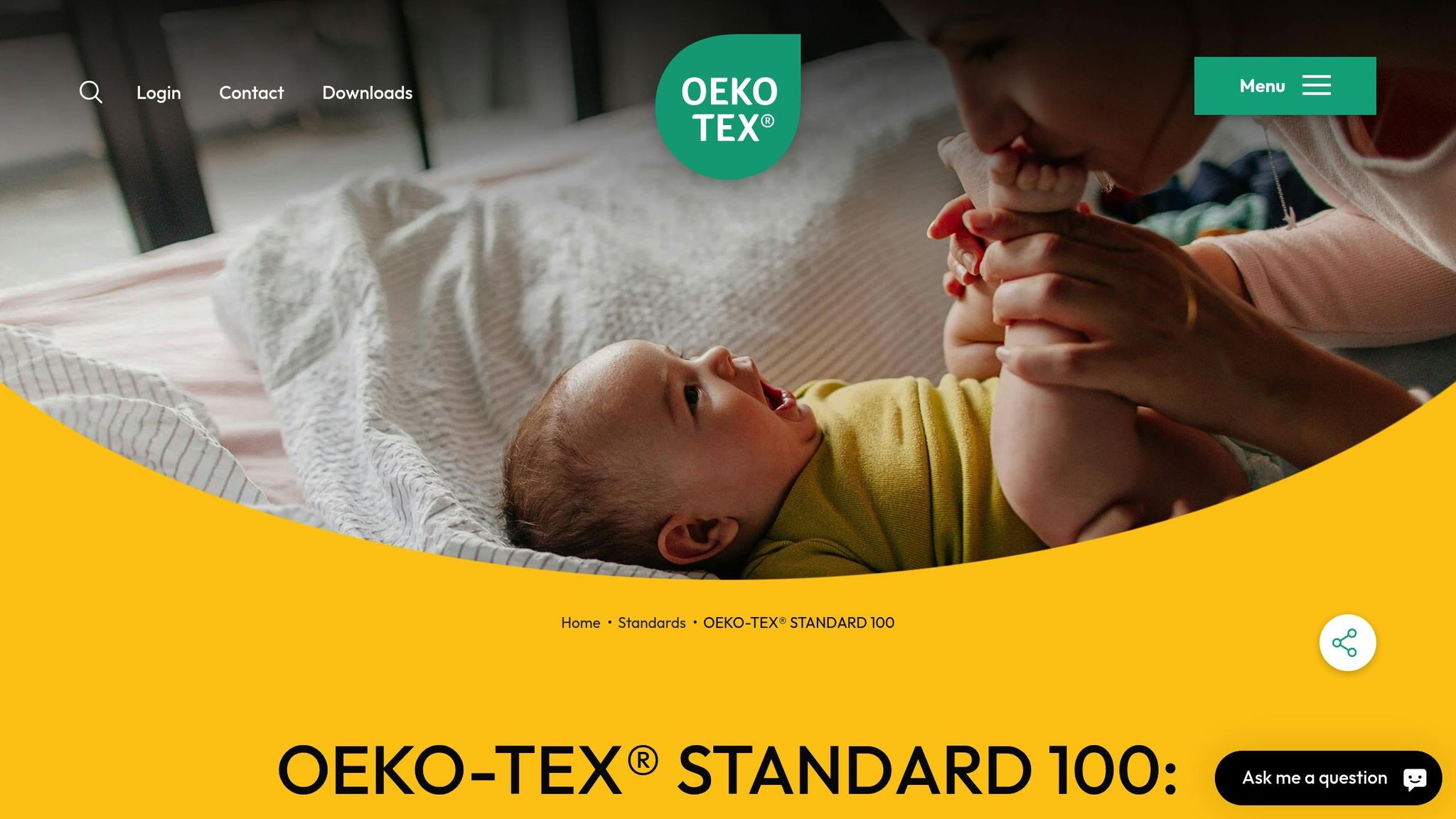- Understand Key Certifications: Look for certifications like Global Recycled Standard (GRS) for recycled materials and OEKO-TEX Standard 100 for chemical safety.
- Check Documents: Request certificates like Compliance, Scope, and Transaction Certificates from your supplier. Verify details such as validity dates, certification numbers, and supplier information.
- Use Official Databases: Cross-check certification numbers on platforms like GOTS, TextileExchange, or OEKO-TEX’s website to confirm their legitimacy.
- Hire Inspectors: Consider third-party audits for additional assurance if documents or database checks leave doubts.
- Build a Verification Process: Develop a checklist to routinely verify certifications, track expiration dates, and maintain organized records.
Why it matters: Verified certifications protect your brand, build customer trust, and ensure compliance with sustainability standards. Start verifying today to stay competitive and meet growing demand for eco-friendly products.
How to find product certification requirements in 3 steps
The Role of Green Certifications
Green certifications connect manufacturers and buyers by independently verifying eco-friendly claims and creating standardized documentation for sustainable practices.
Proof of Standards
These certifications assess key areas such as:
- Material Sourcing: Confirming the use of organic textiles and recycled materials
- Chemical Usage: Ensuring non-toxic dyes and safe processing agents
- Production Methods: Evaluating water-saving and waste-reduction techniques
- Supply Chain: Tracking materials from their origin to the final product
For instance, certification bodies test organic cotton and trace its journey from the farm to the factory. These measurable benchmarks not only validate sustainable practices but also build trust and ensure compliance with industry standards.
Meeting Laws and Customer Needs
Green certifications help manufacturers comply with environmental regulations while meeting growing consumer demand for eco-friendly products. The certification process addresses both legal standards and market expectations by focusing on:
| Aspect | Regulatory Requirements | Customer Benefits |
|---|---|---|
| Documentation | Compliance records | Transparency in manufacturing |
| Testing | Chemical safety verification | Confidence in non-toxic materials |
| Auditing | Facility inspections | Consistent quality assurance |
| Reporting | Environmental impact data | Clear sustainability metrics |
These certifications demonstrate that manufacturers adhere to strict environmental guidelines and provide credible evidence of their eco-friendly practices. Since standards are regularly updated to reflect new laws and advancements, certified companies must stay committed to ongoing improvements. This ensures they remain aligned with legal requirements and shifting consumer expectations for environmentally responsible products.
Main Eco Certifications for Custom Bags
When evaluating eco-friendly custom bags, two key certifications to look for are GRS and OEKO-TEX Standard 100. These certifications confirm the use of recycled materials and ensure product safety.
Global Recycled Standard (GRS)

The Global Recycled Standard (GRS) verifies that recycled materials are genuinely used during production. It requires manufacturers to maintain a clear chain of custody with proper documentation, including collection records, processing certificates, and transaction certificates.
OEKO-TEX Standard 100

The OEKO-TEX Standard 100 guarantees that textiles are free from harmful chemicals. Certified products are assigned a unique ID, which can be verified directly on the OEKO-TEX website. Up next, we’ll explore how to confirm and validate these certifications.
sbb-itb-1e6451b
How to Check Certification Status
Now that eco-certifications are explained, here’s how to confirm they’re legitimate when evaluating custom bag suppliers.
Check Certification Papers
Start by asking your supplier for detailed certification documents. These should include:
- Certificate of Compliance: Lists the certification scope, validity period, and unique ID number.
- Transaction Certificates: Confirms specific orders meet certification standards.
- Scope Certificate: Outlines the products and processes covered under the certification.
Make sure the documents include:
- Valid issue and expiration dates.
- Logos or seals from the certifying body.
- Unique certification numbers.
- Details about the certification scope.
- Supplier name and location that match the records.
After reviewing these, confirm the details through official online databases.
Search Official Databases
Most certification bodies offer online tools to verify certifications. Use these platforms:
- GOTS Database: Check certification numbers at global-standard.org.
- GRS Verification: Use TextileExchange.org for validation.
- OEKO-TEX: Verify label numbers at certification.oeko-tex.com.
When cross-checking, look for:
- Matching company name and location.
- Correct certificate numbers.
- Current certification status.
- Scope of certification.
- Expiration dates.
Work with Outside Inspectors
If you’re uncertain after reviewing documents and databases, consider hiring third-party inspectors for added assurance.
- Pre-shipment Inspection: Inspectors can review documents, production processes, and sourcing records, providing a detailed report on compliance.
This extra step helps ensure your supplier meets the required standards.
Adding Checks to Buying Process
Create a Checklist
To ensure certifications remain valid, develop and stick to a clear checklist for every order.
Document Collection
- Request up-to-date certification documents.
- Save digital copies of certifications.
- Record certification numbers and expiration dates for easy reference.
Verification Steps
- Cross-check certification numbers in official databases.
- Confirm supplier details match the certification records.
- Ensure the certification scope includes the products being ordered.
- Verify that certifications are still valid.
- Keep a record of all verification results.
Organized Documentation
- Store all certification records in a centralized digital system.
- Note expiration dates to avoid lapses.
- Log all verification activities.
- Maintain a clear and accessible audit trail.
Make these steps part of your regular process to ensure ongoing compliance.
Schedule Routine Checks
Stay on top of certification validity by incorporating regular reviews into your workflow.
Monthly Reviews
- Confirm the current status of certifications.
- Update tracking systems with any changes.
- Review and log any new documentation.
Quarterly Audits
- Conduct a detailed review of all supplier certifications.
- Update supplier profiles and address follow-ups.
- Generate compliance reports for internal use.
Annual Assessment
- Perform a full verification of all certifications.
- Revise procedures based on findings.
- Review past compliance records.
- Plan ahead for certification renewals.
Use Automated Tools
- Set calendar reminders for certification expiration dates.
- Enable alerts for database checks and updates.
- Activate notifications for new certification documents.
- Schedule regular backups of your records.
Business Value of Verified Certifications
Verified certifications offer real, measurable benefits that go beyond internal controls, helping businesses thrive in a competitive landscape.
Build Customer Trust
Displaying verified certifications on product labels, marketing materials, and your website shows customers you’re serious about sustainability. This transparency reassures eco-conscious shoppers that your claims are legitimate. Gaining their trust can help set your brand apart.
Stand Out in the Market
Verified certifications can give your business an edge by offering quality validation, marketing opportunities, and compliance assurance.
Quality Validation
Proves your commitment to strict sustainability standards.
Marketing Opportunities
Use these credentials to showcase your transparency and strengthen consumer trust.
Compliance Assurance
Helps you meet current environmental regulations and prepares you for any future changes.
| Business Benefit | Impact |
|---|---|
| Market Growth | Appeals to customers focused on sustainability |
| Brand Reputation | Strengthens your image with verified practices |
| Risk Management | Reduces the likelihood of compliance issues |
| Customer Retention | Builds lasting relationships through openness |
At JUNYUAN BAGS, these certifications are a key part of our commitment to sustainability and play a major role in boosting our credibility in the market.
Conclusion
Verifying certifications for custom bags plays a key role in building business success and earning customer trust. By using official databases, third-party inspections, and regular documentation reviews, companies can back their sustainability claims with confidence and ensure compliance with regulations.
Maintaining valid certifications requires consistent record-keeping and periodic audits. This approach not only helps businesses meet regulatory standards but also strengthens trust with eco-conscious customers.
Certifications like GOTS, GRS, and OEKO-TEX Standard 100 set your brand apart, proving your commitment to sustainable practices. These credentials boost your reputation and foster customer loyalty, offering clear business advantages.
For businesses sourcing custom bags, making certification verification part of standard operations is essential. As environmental awareness grows, verified certifications will be crucial for staying competitive and meeting changing customer demands.
Taking these steps offers clear benefits:
- Comply with environmental regulations
- Build trust through transparency
- Increase demand for sustainable products
- Safeguard your brand’s reputation
Efforts put into certification verification today can lead to a stronger market position and greater customer confidence in the future.




 Mobile/What's App/Wechat
Mobile/What's App/Wechat E-Mail
E-Mail ADD
ADD




